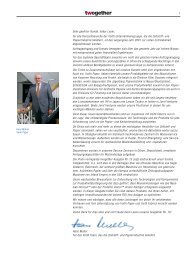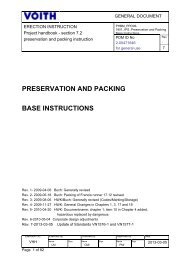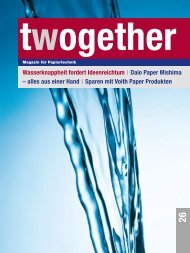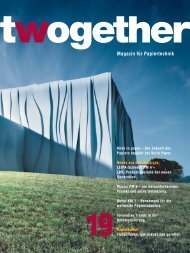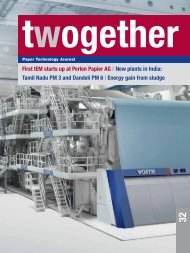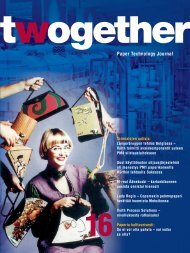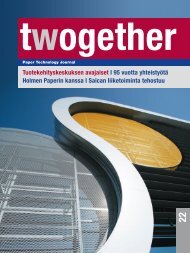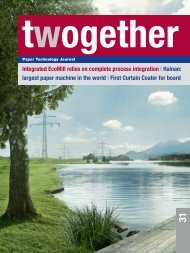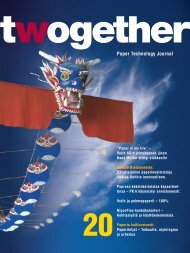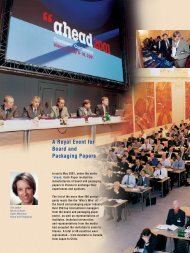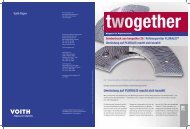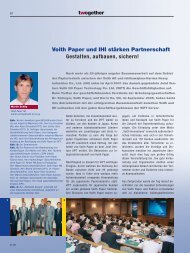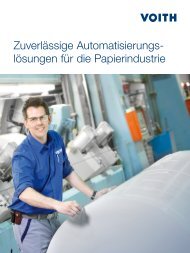You also want an ePaper? Increase the reach of your titles
YUMPU automatically turns print PDFs into web optimized ePapers that Google loves.
6<br />
9<br />
62<br />
Fig. 6: Base paper<br />
PPS roughness results – VPM4.<br />
Fig. 7: SC <strong>Paper</strong><br />
PPS roughness results – VPM4.<br />
Fig. 8: Missing dots (%) – VPM4.<br />
Fig. 9-12: PrintFlex demonstrates superior<br />
printability compared to standard press fabric.<br />
PPS (microns)<br />
Sheet Quality<br />
Depending on the application, the surface<br />
characteristics of the press fabric can<br />
have a variable degree of influence on<br />
paper properties. In shoe press systems,<br />
a long-nip residence time will positively<br />
affect dewatering dynamics, but can also<br />
generate some negative sheet quality<br />
issues. The effect of the press fabric surface<br />
properties on paper quality has<br />
gained a lot of attention in recent years,<br />
especially with single- and tandem-shoe<br />
press configurations.<br />
It is also important to investigate the<br />
influence of the fabric properties beyond<br />
<strong>17</strong>/04<br />
6<br />
5<br />
4<br />
3<br />
2<br />
1<br />
0<br />
Very fine<br />
batt<br />
Medium<br />
batt<br />
PrintFlex P<br />
7<br />
PPS (microns)<br />
1.50<br />
1.25<br />
1.00<br />
0.75<br />
0.50<br />
0.25<br />
0<br />
Very fine<br />
batt<br />
Medium<br />
batt<br />
PrintFlex P<br />
to the end user. Finished paper quality<br />
issues, such as missing dots, can often<br />
be linked to the surface characteristics of<br />
the press fabrics used. Base and finished<br />
sheet properties were evaluated during<br />
the pilot machine trials. PrintFlex P gave<br />
improved PPS results for both the base<br />
and finished paper (Figs. 6 and 7). The<br />
results also confirmed the clear correlation<br />
between the press fabric surface<br />
characteristics and paper smoothness.<br />
Understanding the influence of the press<br />
fabric on finished paper properties has<br />
become an essential segment of <strong>Voith</strong><br />
Fabrics’ continued research and development<br />
work.<br />
10 11<br />
8<br />
Missing dot area, top side (%)<br />
7<br />
6<br />
5<br />
4<br />
3<br />
2<br />
1<br />
0<br />
Very fine<br />
batt<br />
Medium<br />
batt<br />
PrintFlex P<br />
The paper was then submitted for missing<br />
dots evaluation (Fig. 8). As expected,<br />
the ‘medium batt’ fabric had the highest<br />
area of missing dots. PrintFlex P gave an<br />
improvement of over 30 % against this,<br />
with measurable benefits also seen<br />
against the ‘very fine’ fabric.<br />
From a comparison of standard press<br />
fabrics and PrintFlex P (Fig. 9), results<br />
taken from paper made in commercial trials<br />
has confirmed that a reduced fiber<br />
impression within the press nip (Fig. 10),<br />
contributes directly to a smoother sheet<br />
surface profile (Fig. 11) and a significant<br />
improvement in measured printability<br />
(Fig. 12).



